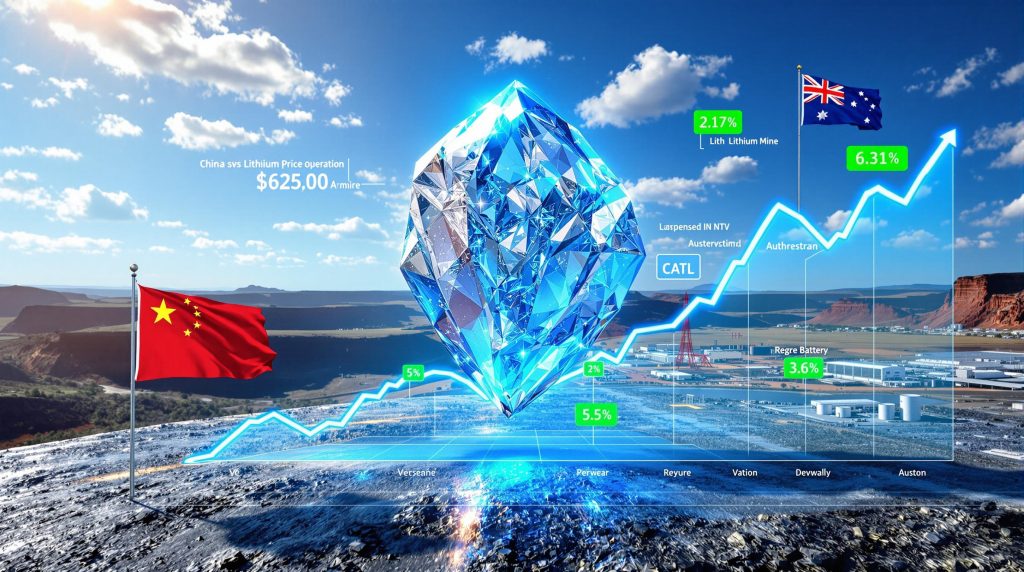Lithium Prices Surge to Yearly Highs: CATL's Production Halt Reshapes Market Outlook
The lithium market has experienced a significant shift in recent weeks, with prices reaching their highest point in over a year. This dramatic reversal from the prolonged downward trend has caught the attention of investors, miners, and industry analysts alike. At the heart of this lithium prices surge as Chinese miner CATL suspends operations, presenting both challenges and opportunities across the global supply chain.
CATL's Unexpected Production Suspension
Contemporary Amperex Technology (CATL) has suspended operations at its Jianxiawo lithium mine in Jiangxi province, creating an immediate supply disruption in the market. This suspension is expected to last up to three months, removing a significant amount of lithium from global supply channels during this period.
The timing of this production halt is particularly noteworthy as it coincides with Beijing's broader investigations into overcapacity across multiple industries, including the lithium sector. Chinese authorities have been increasingly concerned about rapid capacity expansion potentially leading to market imbalances and inefficient resource allocation.
Industry observers note that this regulatory scrutiny represents a shift in China's approach to strategic mineral resources, potentially signaling more disciplined production planning in the future. The immediate effect has been a significant tightening of available supply in an already sensitive market.
Market Response to Supply Disruption
The news of CATL's production suspension triggered an immediate response in commodity markets, with lithium futures in China reaching their highest levels in over a year. This price jump represents a sharp reversal of the previous downward trend that had been driven by persistent oversupply concerns.
Market analysts increasingly view this disruption as a potential turning point after a prolonged period of price depression that had forced numerous producers to curtail operations or delay expansion plans. The sudden supply constraint is accelerating the market's natural rebalancing process.
The timing is particularly significant as it comes just as downstream demand from both electric vehicles and energy storage systems continues to show robust growth. This combination of supply constraint and sustained demand growth creates favorable conditions for continued price support.
How Are Global Demand Factors Influencing Lithium Markets?
The lithium market is experiencing a fundamental shift as demand diversifies beyond its traditional drivers. While electric vehicles remain the primary consumption source, other applications are emerging as significant demand catalysts, creating a more complex and resilient market structure.
Energy Storage Emerging as Key Demand Driver
The energy storage sector is rapidly evolving into a major consumption vector for lithium batteries, complementing demand from electric vehicles. According to BloombergNEF forecasts, new energy storage additions are projected to grow by an impressive 35% in 2025, setting new records for deployment.
This growth translates to approximately 94 gigawatts (247 gigawatt-hours) of new power capacity, representing the largest annual increase ever recorded. The momentum is expected to continue, with projections indicating a compound annual growth rate of 14.7% through 2035.
By the mid-2030s, annual additions are anticipated to reach 220GW and 972GWh, creating sustained demand for lithium and other battery materials. This expansion is being driven by:
- Grid modernization projects requiring large-scale storage solutions
- Renewable energy integration necessitating buffer capacity
- Energy arbitrage opportunities becoming more economically viable
- Resilience requirements from utilities and large power consumers
- Residential and commercial behind-the-meter installations
This diversification of demand sources provides additional stability to the lithium market, reducing its vulnerability to fluctuations in any single sector.
Electric Vehicle Market Expansion
The electric vehicle sector continues its robust growth trajectory, with global sales projected to exceed 20 million units in 2025. This milestone would represent more than 25% of all cars sold worldwide, marking a critical inflection point in transportation electrification.
Recent data from the International Energy Agency (IEA) confirms this momentum, reporting that EVs achieved over 20% market share for the first time in 2024 with more than 17 million units sold globally. The first quarter of 2025 showed even stronger performance with 35% year-on-year growth in global EV sales.
"Despite recent economic headwinds that have put pressure on the auto sector, global sales of electric cars have continued to break records as electric models become increasingly affordable," notes the IEA report.
All major markets set new records for first-quarter sales, demonstrating the broad-based nature of this growth. The IEA further notes that despite significant uncertainties, the EV market share remains on course to exceed 40% by 2030 as electric vehicles become increasingly affordable in more markets.
This sustained growth in the EV sector ensures a strong demand foundation for lithium batteries, particularly as average battery sizes continue to increase with consumer preferences shifting toward larger vehicles with extended range capabilities.
What Does This Mean for Australian Lithium Producers?
The recent price surge offers significant implications for Australia's substantial lithium industry, which had been navigating challenging market conditions. The improved pricing environment could catalyze operational changes and investment decisions across the sector.
Revival Prospects for Australian Operations
The sudden improvement in lithium prices offers welcome relief for Australian miners who had reduced or suspended operations during the extended period of price depression. Several operations that had been placed on care and maintenance may now reassess their production schedules and restart plans as economic viability improves.
The Australian lithium sector had implemented significant cost-cutting measures during the downturn, including:
- Operational streamlining and efficiency improvements
- Deferral of non-essential capital expenditures
- Workforce reductions and reorganizations
- Processing optimizations to improve recovery rates
- Exploration cutbacks and development delays
These adaptations have positioned many Australian producers to respond quickly to improved market conditions, potentially bringing idled capacity back online at lower operational costs than before the downturn.
For projects currently under development, the improved price outlook enhances financial modeling and may accelerate investment decisions that had been delayed during the market trough. This could lead to a more rapid expansion of Australian lithium innovations than previously anticipated.
Projected Export Growth
Australian lithium export earnings are forecast to increase substantially in the coming years, rising from $4.6 billion in 2024-25 to $6.6 billion in 2026-27 according to government projections. This growth will be primarily driven by increased export volumes, particularly of higher-value lithium hydroxide as Australian producers move up the value chain.
Mine output is expected to grow by more than 7% annually through 2027, reflecting both the restart of idled capacity and the development of new projects. This production growth aligns with the anticipated increase in global demand, allowing Australia to maintain its position as a leading lithium supplier.
The country's focus on downstream processing capacity represents a strategic shift toward higher-value products. New hydroxide plants coming online will enable Australian producers to capture more of the value chain, moving beyond the export of raw spodumene concentrate to supply refined materials directly to battery manufacturers.
| Fiscal Year | Export Value (AUD billions) | Primary Growth Drivers |
|---|---|---|
| 2024-25 | 4.6 | Baseline production, price recovery |
| 2025-26 | ~5.6* | Increased mine output, hydroxide production ramp-up |
| 2026-27 | 6.6 | Full hydroxide capacity utilization, continued price support |
*Estimated based on projected growth trajectory
How Does This Price Surge Fit into the Broader Lithium Market Cycle?
The lithium market has demonstrated classic cyclical behavior over recent years, with the current price surge representing a potential inflection point in this cycle. Understanding this pattern provides important context for assessing the sustainability of the current recovery.
Supply-Demand Rebalancing
The lithium market had experienced a significant oversupply condition leading to a sustained price decline that forced miners to shut down or reduce operations. This production discipline has been gradually reducing the supply overhang, with CATL's production suspension now accelerating this rebalancing process.
Several factors contribute to this market rebalancing:
- Production cuts from major suppliers reducing available material
- Project delays extending timelines for new capacity
- Investment reductions limiting future supply growth
- Accelerating demand from both EVs and energy storage
- Strategic stockpiling by battery manufacturers and OEMs
The current disruption helps compress the timeline for market rebalancing that was already underway. Continued production discipline from major producers could stabilize prices at levels that support sustainable industry economics without triggering another wave of overexpansion.
Industry analysts note that the lithium market tends to overcorrect in both directions, with periods of tight supply and high prices triggering aggressive capacity expansion that eventually leads to oversupply. The key question is whether producers have learned from the recent downcycle and will approach expansion more cautiously.
Long-Term Market Outlook
Despite short-term volatility, the structural demand growth for lithium remains robust across multiple end-use sectors. The electric vehicle market continues its expansion trajectory, with market share projected to exceed 40% by 2030 according to IEA forecasts.
Energy storage applications are adding significant new demand vectors, with utility-scale deployments accelerating globally as renewable energy penetration increases. This diversification of demand provides greater market stability than in previous cycles.
On the supply side, constraints may emerge as production struggles to match accelerating demand. Key challenges include:
- Project development timelines typically extending 3-5 years from investment decision to production
- Resource quality issues as easier deposits are depleted
- Processing technology constraints for complex ore bodies
- Water availability concerns in many lithium-rich regions
- Regulatory and permitting hurdles extending project timelines
- Capital constraints following the previous market downturn
These factors suggest that while supply will eventually respond to higher prices, the response may be more measured and time-consuming than in previous cycles, potentially supporting a longer period of price strength.
What Are the Investment Implications of This Price Movement?
The dramatic jump in lithium prices since early July presents significant investment implications across the battery supply chain. Investors are reassessing their exposure to the sector in light of improving fundamentals.
Potential Impact on Lithium Stocks
Share prices of lithium producers have responded positively to the news of CATL's production suspension and the subsequent price recovery. Companies with operational flexibility may benefit most from price volatility, particularly those able to quickly ramp up production to capitalize on improved market conditions.
Investors appear to be reassessing previously devalued lithium assets, with renewed interest in companies that:
- Maintained operational readiness during the downturn
- Possess high-quality resources with favorable economics
- Have secured offtake agreements with major battery manufacturers
- Demonstrate technological advantages in processing or extraction
- Maintain strong balance sheets with limited leverage
The market is likely to differentiate more clearly between producers based on cost position, product quality, and customer relationships. Companies capable of producing battery-grade materials consistently will command premium valuations compared to those limited to technical-grade products.
Risk Factors to Consider
While the current price recovery is encouraging, several risk factors merit consideration when evaluating investment opportunities in the sector:
- Chinese regulatory actions remain unpredictable and could quickly shift market dynamics
- Supply response to higher prices could accelerate more rapidly than anticipated
- EV adoption rates remain subject to economic conditions and government policy support
- Technological disruption in battery chemistry could alter material requirements
- Substitution risk increases as prices rise, potentially accelerating development of alternatives
Investors should maintain a balanced perspective that recognizes both the improved near-term outlook and the continuing structural volatility of the lithium market. A diversified approach to battery material exposure may provide more stable returns than concentrated positions in single commodities or companies.
Global EV Market Growth Trajectory
The electric vehicle market continues its remarkable expansion, driving fundamental changes in automotive manufacturing, energy systems, and mineral markets. Understanding this growth trajectory provides essential context for global lithium market trends.
| Year | Global EV Sales (millions) | Market Share (%) | Year-on-Year Growth (%) |
|---|---|---|---|
| 2024 | 17+ | 20+ | – |
| 2025 (projected) | 20+ | 25+ | 17.6+ |
| 2030 (projected) | – | 40+ | – |
This growth is supported by several converging factors:
- Battery cost reductions improving economic competitiveness
- Model proliferation across all vehicle segments and price points
- Charging infrastructure expansion reducing range anxiety
- Government incentives and regulations supporting adoption
- Consumer preference shifts as awareness of benefits increases
While growth rates may moderate from the explosive early adoption phase, the absolute volume increases remain substantial as the overall market share expands. This provides a solid foundation for continued lithium demand growth through the coming decade.
FAQ: Understanding the Lithium Market Dynamics
How does CATL's production suspension affect global lithium supply?
CATL's Jianxiawo operation represents a significant portion of Chinese domestic lithium production. The three-month suspension creates an immediate supply gap in a market that was previously considered oversupplied, helping to rebalance global markets faster than anticipated.
The impact is amplified by the operation's position as a domestic Chinese supplier, as China has been working to reduce dependency on imported materials. This disruption may increase China's near-term import requirements, creating ripple effects through global supply chains.
The duration of this suspension will be crucial in determining the longer-term market impact. If extended beyond the initially announced three months, or if it signals a more permanent shift in Chinese production strategy, the effects could be substantially more significant for global supply-demand balances.
Why is energy storage becoming increasingly important for lithium demand?
Energy storage systems require substantial lithium for battery components. As renewable energy adoption accelerates globally, the need for grid-scale and residential storage solutions is growing exponentially, creating a major new demand vector beyond electric vehicles.
Several factors drive this growth:
- Intermittency management for wind and solar generation
- Peak demand reduction capabilities saving infrastructure costs
- Grid resilience improvements during extreme weather events
- Energy arbitrage opportunities between low and high-price periods
- Microgrid development for remote and critical infrastructure
Unlike electric vehicle demand, which can be sensitive to economic cycles and consumer sentiment, utility-scale storage deployment often follows long-term infrastructure planning cycles. This provides a more stable and predictable demand component that complements the consumer-driven EV market.
What factors will determine if this price surge is sustainable?
The sustainability of higher lithium prices depends on several factors: the duration of CATL's production suspension, whether other producers increase output in response, the pace of EV adoption globally, and potential new lithium projects coming online in the next 12-24 months.
Market balance will also be influenced by:
- Inventory levels throughout the supply chain
- Battery manufacturer purchasing patterns and stockpiling behavior
- Chemical conversion capacity keeping pace with mining output
- Product quality requirements becoming more stringent
- Regional supply-demand imbalances affecting trade flows
The historical pattern suggests that periods of higher prices eventually stimulate supply responses that moderate price levels. However, the lead time for new lithium projects means this response may be slower than in previous cycles, potentially supporting prices for a more extended period.
How does Australia's lithium industry compare globally?
Australia remains one of the world's largest lithium producers, primarily through hard-rock mining operations. The country's projected 7% annual growth in production through 2027 positions it to maintain its significant global market share, particularly as demand for battery-grade materials increases.
Australian operations have several competitive advantages:
- Established mining expertise and infrastructure
- High-quality spodumene deposits suitable for battery applications
- Stable regulatory environment supporting investment
- Growing downstream processing capacity adding value locally
- Strategic positioning for Asian markets, particularly Japan and Korea
The country's continued investment in processing capabilities represents a strategic evolution from being primarily a raw material supplier to becoming an integrated part of the battery supply chain. This transition enhances the value capture potential for Australian operators while providing supply diversification for battery manufacturers seeking alternatives to Chinese processing capacity.
Market Insight: The lithium market demonstrates classic cyclical behavior, with periods of oversupply leading to price collapses followed by production cuts that eventually create supply shortages and price recoveries. The current situation with CATL's production suspension may accelerate this natural market rebalancing.
Investment Consideration: While short-term price movements create trading opportunities, the long-term structural growth in lithium demand from both EVs and energy storage applications suggests sustained demand growth through 2035 and beyond. Investors may benefit from focusing on producers with quality assets, operational flexibility, and strong balance sheets capable of weathering market volatility.
Australian Lithium Export Forecast
Australia's position as a key global supplier of lithium raw materials and increasingly refined products shapes both the domestic mining sector and international supply chains. The country's export earnings trajectory reflects the anticipated recovery in both prices and volumes.
| Fiscal Year | Export Value (AUD billions) | Growth Drivers |
|---|---|---|
| 2024-25 | 4.6 | Base production |
| 2025-26 | ~5.6* | Increased mine output, price recovery |
| 2026-27 | 6.6 | Higher lithium hydroxide volumes |
*Estimated based on projected growth trajectory
This forecast growth represents a significant turnaround from the
Want to Profit from the Next Major Mineral Discovery?
Discover investment opportunities ahead of the market with Discovery Alert's proprietary Discovery IQ model, which instantly identifies significant ASX mineral discoveries and transforms complex data into actionable insights. Explore why historic discoveries have generated substantial returns by visiting Discovery Alert's dedicated discoveries page and begin your 30-day free trial today.




